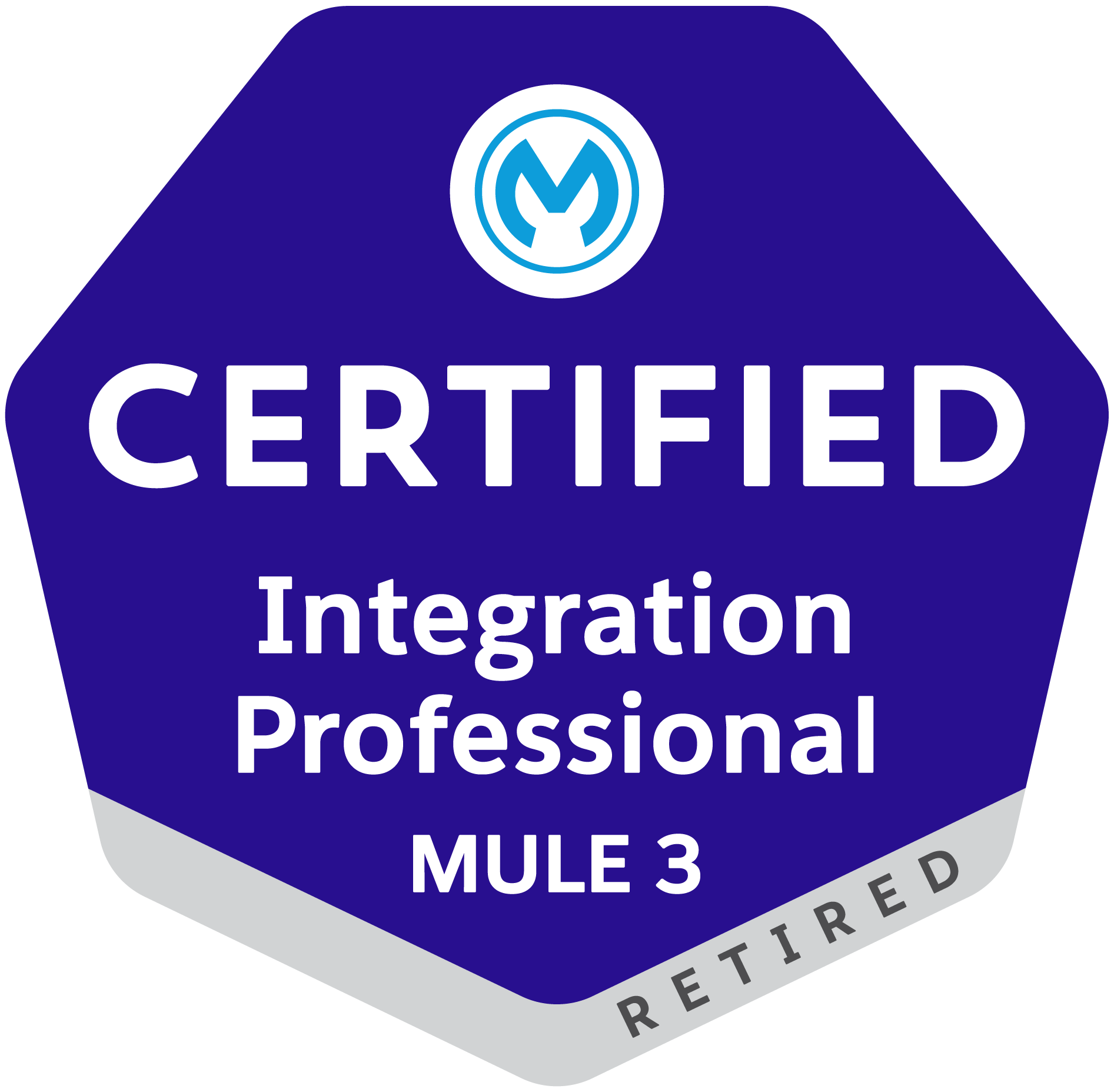
Summary
Note: On June 30, 2022, this certification exam was retired. Existing certifications remain valid for their full 2 years.
A MuleSoft Certified Developer – Integration Professional should have extensive, real-world MuleSoft development experience and be able to develop and provide technical leadership on complex Anypoint Platform integration projects. The MCD – Integration Professional (Mule 3) exam validates that a developer has the required knowledge and skills to:
- Create and configure flows, subflows, and flow processing strategies for reusability and performance.
- Select and use appropriate types of transformers and modules to persist data and write MEL expressions to access and modify messages.
- Write DataWeave expressions to transform data.
- Control message content, flow, and processing by selecting and implementing appropriate connectors, routers, scopes, and filters.
- Design and implement comprehensive error handling strategies for applications.
- Implement and consume REST and SOAP web services.
- Create and use custom Java components.
- Use JUnit and MUnit to test Mule applications.
- Configure and deploy Mule applications to CloudHub and/or single or clusters of customer-hosted Mule runtimes.
Format
- Format: Multiple-choice, closed book, proctored, online
- Length: 100 questions
- Duration: 120 minutes (2 hours)
- Pass score: 80%
- Language: English
Cost
You can no longer purchase this exam.
Validity
The certification expires two years from the date you pass the exam.
Topics
The exam validates that you can perform the following tasks.
| General |
- Explain basic MuleSoft implementation and design concepts.
- Track data movement through an application.
|
| Basics |
- Identify when to use and use flow variables and session variables.
- Write Mule expressions.
- Define Mule properties and create properties files.
|
| HTTP Connector |
- Create and configure inbound and outbound HTTP endpoints.
- Use HTTP and HTTPS.
- Define HTTP content-type and explain its effect on browser types.
|
| Flows |
- Use flows, sub-flows, and flow references.
- Explain the differences between inbound and outbound endpoints.
- Configure flow processing strategies.
- Code and test exchange patterns (including request-response and one-way).
- Test Mule applications using JUnit and MUnit cases.
- Send a Mule message from a test class to a Mule application.
|
| Flow control |
- Use splitters, aggregators, and multicast routers.
- Use the For-each scope.
- Use filters.
|
| Error handling |
- Debug flows and expression handlers.
- List the different exception strategies that are available.
- Use exception strategies and explain how they affect flows and sub-flows.
- Change and return a message from an exception strategy.
- Configure global application exception handling.
- Use routers (including First Successful and Until Successful) to handle potential error conditions.
|
| Transformations with DataWeave |
- Write DataWeave scripts to convert JSON, XML, and Java data structures to different data structures and data types.
- Use DataWeave operators.
- Define and use custom data types.
- Apply correct DataWeave syntax to coerce data types.
- Apply correct DataWeave syntax to format strings, numbers, and dates.
- Call Mule flows from a DataWeave script.
- Call global MEL functions from a DataWeave script.
|
| Web services |
- Implement REST services with GET, POST, PUT, and DELETE methods.
- Use annotations on REST methods to create unique signatures.
- Create REST clients and working with dynamic endpoints.
- Publish and consume SOAP messages.
- Use CXF interfaces to create service definitions.
- Extend interfaces to create CXF implementations.
|
| Scopes |
- Configure and use batch processing.
- Use the Cache Scope to store and reuse frequently called data.
- Create and manage caching strategies.
- Use Enrichers to enhance a Mule message.
|
| Deployment |
- Explain the general concepts and benefits of building Mule clusters.
- Manage runtime clusters.
- Use queues to distribute application flows for processing in clusters.
- Describe how clustering supports various Mule transport mechanisms.
- Deploy applications to customer-hosted Mule runtimes.
- Deploy applications to CloudHub.
- Organize Spring properties and Spring property file configuration.
|
| Java components |
- Create and test Java custom components and integrating them into flows.
- Use advanced Java concepts to invoke service calls for passing Mule messages.
- Create custom filters with Java.
- Configure Java components to be prototypes or singletons.
- Use the default entry point resolver with Java components.
|
| Connectors and transports |
- Configure and use Database connectors.
- Explain how Database inbound and outbound endpoints differ and their limitations.
- Configure JMS connectors for two-way communications, temporary queues, and object serialization over transports.
- Use back channels and creating two-way communication through JMS connections.
- Describe how JMS uses correlation IDs.
- Use VM Transport to control how messages are sent and received by components in a system.
- Use VM Transport for communication between Mule flows.
- Explain queue usage with VM Transport and configuration structure.
- Configure and use File and FTP connectors.
|
| Transactions |
- Explain transaction management.
- Identify which endpoints support transactions.
- Manage and configure resource transactions for inbound and outbound messages.
- List the various transaction types and usage techniques.
|
2 hours
Virtual
